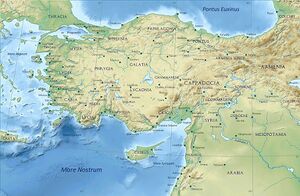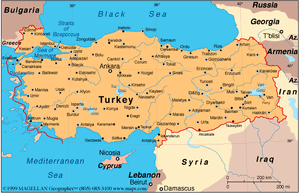Gangra
| Author:Laxman Burdak, IFS (R) |


Gangra is a historical city presently called Çankırı, the capital city of Çankırı Province, in Turkey. Pliny has mentioned it as Gangre. [1]
Variants
- Cankiri
- Çankırı
- Changra
- Gagra for the Jews and
- Gangra (Greek: Γάγγρα)
- Gangre (Pliny.vi.2)
- Germanicopolis (Greek: Γερμανικόπολις)
- Hangara for the Arabs
- Kandari
- Kanghari
- Kângıri or Çankıri for the Turks
- Kankiri
- Tzungra for the Turks
Jat clans
Places in India
- Gagra (Village in Ludhiana, Punjab)
- Kanker is a city and district in Chhattisgarh.
Location
Çankırı is about 140 km northeast of Ankara. It is situated about 800 m (2500 ft) above sea level.
History
Çankırı was known in antiquity as Gangra (Greek: Γάγγρα), and later Germanicopolis (Greek: Γερμανικόπολις). The city has also been known as Changra, Kandari or Kanghari.
Α town of Paphlagonia that appears to have been once the capital of Paphlagonia and a princely residence, for it is known from Strabo that Deiotarus Philadelphus (before 31 BC–5/6 AD), the last king of Paphlagonia, resided there.[2]Notwithstanding this, Strabo describes it as only "a small town and a garrison".
According to 1st-century BC writer Alexander the Polyhistor[3] the town was built by a goat herder who had found one of his goats straying there; but this origin is probably a mere philological speculation as gangra signifies "a goat" in the Paphlagonian language.
Gangra was absorbed into the Roman province of Galatia upon the death of Deiotarus in 6/5 BC. The earlier town was built on the hill behind the modern city, on which are the ruins of a late fortress, while the Roman city occupied the site of the modern city.[4]
In the writings of the 2nd-century AD Greco-Roman writer Ptolemy, the city is referred to as Germanicopolis (Greek: Γερμανικόπολις).[5][6] It was named Germanicopolis, after Germanicus or possibly the emperor Claudius, until the time of Caracalla.
In Christian times, Gangra was the metropolitan see of Paphlagonia.[7] Hypatios, bishop of Gangra, is considered a saint in the Orthodox Christian tradition. He was killed by Arians on his return from the Council of Nicaea (325 AD), in which he took part.
In the 4th century, the town was the scene of an important ecclesiastical synod, the Synod of Gangra. There is disagreement about the date of the synod, with dates varying from AD 341 to 376. The synodal letter states that twenty-one bishops assembled to take action concerning Eustathius of Sebaste[8] and his followers. The synod issued twenty canons known as the Canons of Gangra; these were declared ecumenical by the Council of Chalcedon in 451. Under these canons, the sect disowned marriage, disparaged the offices of the church, held conventicles of their own, wore a peculiar dress, denounced riches, and affected special sanctity. The synod condemned the Eustathian practices, declaring however that it was not virginity that was condemned, but the dishonouring of marriage; not poverty, but the disparagement of honest and benevolent wealth; not asceticism, but spiritual pride; not individual piety, but dishonouring the house of God.[9]
Over the centuries the settlement witnessed the hegemony of many cultures and races, such as Hittites, Persians, ancient Greeks, Parthians, Pontic Greeks, Galatians, Romans, Byzantine Greeks, up to the Seljuks and finally the Ottoman Turks. Traces from its long past are still visible throughout the city. The continuity of the city's name from ancient times across languages is of note: Hangara for the Arabs, Gagra for the Jews and Tzungra or Kângıri or Çankıri for the Turks.
Mention by Pliny
Pliny[10] mentions...We then come to the river Evarchus13, and after that a people of the Cappadocians, the towns of Gaziura14 and Gazelum15, the river Halys16, which runs from the foot of Mount Taurus through Cataonia and Cappadocia, the towns of Gangre17 and Carusa18, the free town of Amisus19, distant from Sinope one hundred and thirty miles, and a gulf of the same name....
13 The boundary, according to Stephanus Byzantinus, also of the nations of Paphlagonia and Cappadocia. As Parisot remarks, this is an error, arising from the circumstance of a small tribe bearing the name of Cappadocians, having settled on its banks, between whom and the Paphlagonians it served as a limit.
14 On the river Iris. It was the ancient residence of the kings of Pontus, but in Strabo's time it was deserted. It has been suggested that the modern Azurnis occupies its site.
15 In the north-west of Pontus, in a fertile plain between the rivers Halys and Amisus. It is also called Gadilon by Strabo. D'Anville makes it the modern Aladgiam; while he calls Gaziura by the name of Guedes.
16 Now called the Kisil Irmak, or Red River. It has been remarked that Pliny, in making this river to come down from Mount Taurus and flow at once from south to north, appears to confound the Halys with one of its tributaries, now known as the Izchel Irmak.
17 Its site is now called Kiengareh, Kangreh, or Changeri. This was a town of Paphlagonia, to the south of Mount Olgasys, at a distance of thirty-five miles from Pompeiopolis.
18 A commercial place to the south of Sinope. Its site is the modern Gherseh on the coast.
19 Now called Eski Samsun; on the west side of the bay or gulf, anciently called Sinus Amisenus. According to Strabo, it was only 900 stadia from Sinope, or 112 1/2 Roman miles. The walls of the ancient city are to be seen on a promontory about a mile and a half from the modern town.
References
- ↑ Pliny.vi.2
- ↑ Strabo. xii. p.5
- ↑ Smith, W., Dictionary of Greek and Roman Biography and Mythology, vol. 3, s.v. "Stephanus" of Byzantium.
- ↑ Chisholm, Hugh, ed. (1911). "Changra". Encyclopædia Britannica. Vol. 5 (11th ed.). Cambridge University Press. p. 840.
- ↑ Ptol., Geo. v. 4. § 5, but also "Gangra (Byzantium)"
- ↑ Encyclopaedia of the Hellenic World, Asia Minor
- ↑ Chisholm, Hugh, ed. (1911). "Changra". Encyclopædia Britannica. Vol. 5 (11th ed.). Cambridge University Press. p. 840.
- ↑ Herbermann, Charles, ed. (1913). "Eustathius of Sebaste" . Catholic Encyclopedia. New York: Robert Appleton Company.
- ↑ Chisholm, Hugh, ed. (1911). "Changra". Encyclopædia Britannica. Vol. 5 (11th ed.). Cambridge University Press. p. 840.
- ↑ Natural History by Pliny Book VI/Chapter 2
Back to Jat Places in Turkey/Back to Jat Places in Anatolia

